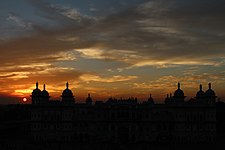Janaki Mandir
| Janaki Mandir | |
|---|---|
जानकी मन्दिर | |
 Front view of Janaki Mandir | |
| Religion | |
| Affiliation | Hinduism |
| District | Dhanusa District |
| Province | Province No. 2 |
| Deity | Sita (Janaki), Rama |
| Festivals | Vivaha Panchami, Rama Navami, Dashain, Tihar-Deepawali and Chhath |
| Location | |
| Location | Janakpurdham |
| Country | Nepal |
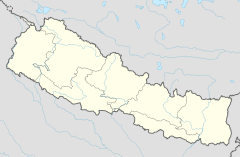 Location in Nepal | |
| Geographic coordinates | 26°43′50″N 85°55′32″E / 26.73056°N 85.92556°ECoordinates: 26°43′50″N 85°55′32″E / 26.73056°N 85.92556°E |
| Architecture | |
| Type | Hindu-Kushwaha |
| Completed | 1967 BS (1910 AD) |
| Specifications | |
| Temple(s) | 70 |
| Monument(s) | 27 |
| Elevation | 78 m (256 ft) |
Janaki Mandir (Nepali: जानकी मन्दिर) is a Hindu temple in Janakpur in the Mithila region of Nepal, dedicated to the Hindu goddess Sita. It is an example of Hindu-Koiri Nepali architecture. It is often considered the most important model of Koiri architecture in Nepal. Fully built in bright white and constructed in an area of 1,480 square metres (4,860 sq. feet) in a mixed style of Mughal and Koiri domes.[1] It is a three-storied structure made entirely of stone and marble. All its 60 rooms are decorated with the flag of Nepal, colored glass, engravings, and paintings, with beautiful lattice windows and turrets. According to legends and epics, King Janak ruled this area (called Videha) during the Ramayana period. His daughter Janaki (Sita), during her swyambar, had chosen Lord Rama as her husband, and become the queen of Ayodhya. Their marriage ceremony had occurred in the nearby temple which is also called vivaha mandap. The site was designated as a UNESCO tentative site in 2008.[2]
History[]
The mandir is popularly known as the Nau Lakha Mandir (meaning "nine lakhs"). The cost for the construction of the temple was about the same amount of money: rupees nine lakhs or nine hundred thousand, hence the name. Queen Vrisha Bhanu of Tikamgarh built the temple in 1910 AD.
In 1657, a golden statue of the Goddess Sita was found at the very spot, and Sita is said to have lived there. The legend said it that it was built on the holy site where Sannyasi Shurkishordas had found the images of Goddess Sita. In fact, Shurkishordas was the founder of modern Janakpur and the great saint and poet who preached about the Sita Upasana (also called Sita Upanishad) philosophy. Legend has claimed it that King Janak(Seeradhwaj) performed the worship of Shiva-Dhanus on this site.
As of 26 April 2015, the temple is reported to have partly collapsed from the earthquake in April 2015.[3]
Pilgrimage[]
Every year, thousands of pilgrims from Nepal, India, Sri Lanka, and other countries visit Ram Janaki Temple to worship Lord Ram and Sita. Many worshippers visit the temple during the festivals of Ram Nawami, Vivaha Panchami, Dashain and Tihar.
Gallery[]

Panoramic view (September 22, 2016)
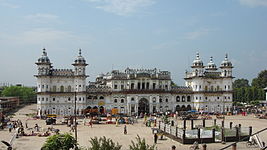
Front view (October 14, 2007)
Sunset view (November 2, 2012)
Early morning view (November 2, 2012)
Inside view
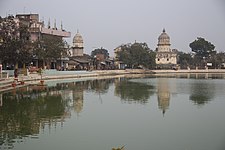
Ganga Sagar
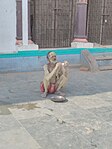
Saadhu in Janaki Mandir
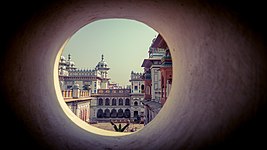
Janaki Mandir

view Janaki Mandir

Janaki Mandir on the occasion of Ram Navami.

Janaki Mandir top corner view
See also[]
References[]
- ^ "Janaki Mandhir". Lonely planet. 30 July 2017. Retrieved 30 July 2017.
- ^ https://whc.unesco.org/en/tentativelists/5261/
- ^ "Nepal Earthquake Takes Heavy Toll on Temples". NDTV. 26 April 2015. Retrieved 3 May 2015.
External links[]
- Sita Upanishad
- Janaki Mandir on Google Maps
- Janki Mandir official Website
- Hindu temples in Janakpur
- Sita temples
- 1910 establishments in Nepal



